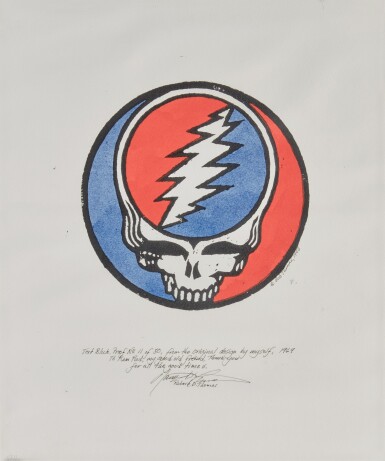
Property of Strider Shurtliff
Bob Thomas | Steal Your Face logo, printed by Thomas and given to Ram Rod
Lot Closed
October 14, 06:29 PM GMT
Estimate
6,000 - 8,000 USD
Lot Details
Description
Property of Strider Shurtliff
Bob Thomas
Steal Your Face wood block print, signed and numbered
Color print (16.375 x 13.5’’). Large woodblock print of the Steal Your Face logo in red, blue, and black at center, numbered and signed “Test Block. Proof No. 11 of 50, from the original design by myself, 1969 | To Ram Rod, my good old friend, Thank you | for all the good times. Robert D. Thomas”; slight ink smudge to lower right of woodcut from printing. Matted and framed; not examined out of frame.
Steal Your Face woodblock print, given to Ram Rod
Bob Thomas first came into contact with the Dead while working as Owsley “Bear” Stanley’s lab assistant, synthesizing LSD. Thomas was a painter who worked in numerous styles, and was responsible for creating one of the most iconic images in the world: the Dead’s Steal Your Face logo. The impetus for the logo originally came from an issue while touring: “With all of the bands using more or less identical road caes, Bear had concluded that a simple, easily identified logo would be useful. He had envisioned a simple symbol that was a bolt of lightning in a red and blue circle with a white border, but … Bob Thomas delivered a more refined rendering in which a skull, the forehead cleaved by a lightning bolt, would fill a circle. The bolt had thirteen points, as in the number of stripes in the U.S. flag, and its colors were red, white, and blue” (McNally, 337).
The image would go on to become an indispensable piece of Grateful Dead iconography, recognized as synonymous with the band around the world. While it was known by fans from their road cases and art for several years, it was immortalized when it was used for the cover of the 1976 live double album Steal Your Face. From then on, the image itself was known as “Steal Your Face” or, affectionately, “Stealie.”
REFERENCE
McNally, Dennis. A Long Strange Trip. New York: Broadway Books, 2002
You May Also Like







